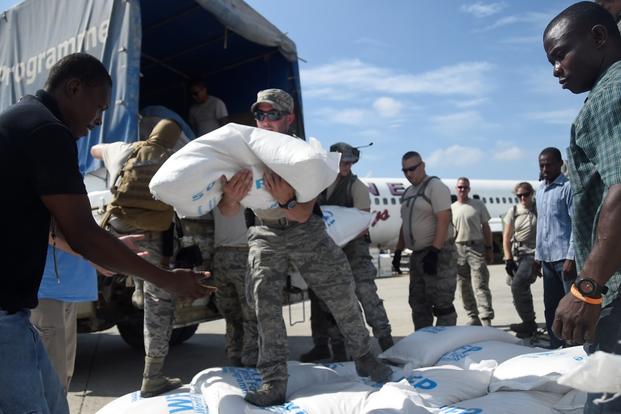The U.S. Air Force has played a key role in coordinating the recent arrival of more than two dozen aircraft from countries around the world delivering supplies to hurricane-stricken Haiti.
In the last five days alone, the service has ushered in 27 aircraft from not only the U.S., but also Germany, France, China and countries in Latin America, according to service members interviewed by Military.com on Tuesday.
More activity is expected, especially in cities such as Jérémie, relatively isolated by deep forests to the south but slammed up against the Atlantic Ocean to the north.
U.S. Southern Command last week established Joint Task Force-Matthew to oversee U.S. military relief efforts in Haiti after Category 4 Hurricane Matthew ravaged the island, displacing more than 300,000 inhabitants and killing nearly 1,000, according to reports.
More than 115 airmen from the 621st Contingency Response Wing out of Joint Base McGuire-Dix-Lakehurst, New Jersey, repurposed Port-au-Prince International Airport in just 12 hours to function as the checkpoint for all airlift operations, as part of their Joint Task Force-Port Opening mission.
While not in charge of potable water or medical relief, the airmen have been the air traffic controllers, maintenance delegators, relief aid offloaders -- "anything you need for an airfield, we do," said Staff Sgt. Robert Waggoner, a spokesman for the wing.
"We've been working with people from so many different nations, with many language barriers, [but still] finding a way to get this mission done," Waggoner said during a telephone interview with Military.com from Haiti.
The Air Force has been transferring supplies to the Marine Corps and Army, sending UH-60 Black Hawks and CH-47 Chinooks to marooned parts of the island, said Col. Leslie Maher, the commander of the JTF-Port Opening mission.
"The only way in through Jérémie and that part of Haiti was through a bridge, now washed away because of the hurricane, so the only way in [now] is through helicopter," Waggoner said. The limited airstrip in Jérémie, about 180 miles away from Port au Prince, cannot accommodate large cargo aircraft.
As of Monday, three of five U.S. cargo planes had delivered 480 metric tons of relief supplies, including 20,000 hygiene kits, 18,000 sets of kitchen utensils for cooking, 40,000 blankets and 500 rolls of plastic sheeting or tarps, plus hundreds of pounds of rice.
Maher said as "we progress on getting the supplies out, we'll see" if the JTF-PO will relocate or create another airfield.
In addition to a growing cholera scare on the island, another obstacle has been connecting with desperate communities who sometimes refuse to cooperate or even grow hostile toward the convoy attendants carrying aid.
"We're the first unit that goes in, and the last one that goes out," Maher said, adding that the order has been given to stick to a 14-day mission, concluding around Oct. 19.
"We've brought the forklifts, the Halvorsen [25K Loaders], the all-terrain Humvees, and the security and communications," she said, "so all of the back-end infrastructure that's needed to make an operation like this possible."
Maher said it might seem like a small footprint, but it's enough to begin getting Haiti's "economy and micro-economies back on their feet again."
"It's the guys that drive the forklift that often get overlooked, but they're the ones helping to offload … any aircraft that's dropping into a very, very tight airport. Yes, it's the helicopters that get it out there, but the logistical side makes it successful, too," she said.
-- The Associated Press contributed to this report.
-- Oriana Pawlyk can be reached at oriana.pawlyk@military.com. Follow her on Twitter at@Oriana0214.



























